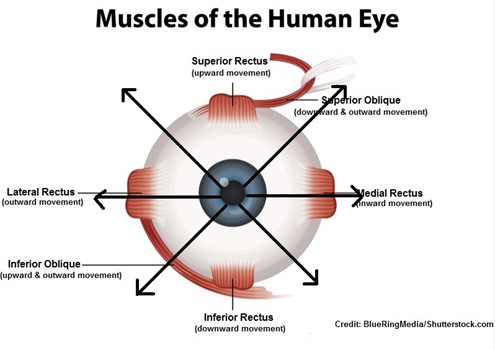The nurse is assessing the 6 stages of cardinal gaze. This test assesses:
Cranial nerves III, IV, and X for eye muscle strength.
Cranial nerves III, IV, and VI for ocular motor movements.
Cranial nerves IV, V and VII for visual accuracy.
Cranial nerve II for visual acuity.
The Correct Answer is B
The nurse is assessing the 6 stages of the cardinal gaze to evaluate the function of the cranial nerves III, IV, and VI for ocular motor movements, which control eye movement and positioning.
Cranial nerve III controls the superior rectus, inferior rectus, and medial rectus muscles, which move the eye up, down, and inward, respectively. Cranial nerve IV controls the superior oblique muscle, which moves the eye downward and laterally. Cranial nerve VI controls the lateral rectus muscle, which moves the eye outward.
Therefore, the nurse will observe the patient's ability to move their eyes smoothly in each of the six cardinal positions of gaze and note any abnormalities that may indicate dysfunction of these cranial nerves. This test is used to diagnose conditions such as strabismus, nystagmus, and palsy of the ocular motor nerves.
Cranial nerve II, on the other hand, is responsible for visual acuity, not eye movement, and is tested separately using a visual acuity chart or other vision tests.

Nursing Test Bank
Naxlex Comprehensive Predictor Exams
Related Questions
Correct Answer is C
Explanation
REM (Rapid Eye Movement) sleep is a stage of sleep that is part of the sleep cycle, which also includes non-REM (NREM) sleep. Dreaming occurs during REM sleep, and it usually composes about 20-25% of total sleep time in adults. NREM sleep, on the other hand, makes up the largest amount of total sleep time, typically about 75-80%. Both REM and NREM sleep are important for restorative sleep, but each plays a different role in physiological and cognitive functioning.

Correct Answer is D
Explanation
The sense of taste is primarily mediated by the facial nerve (cranial nerve VII) and the glossopharyngeal nerve (cranial nerve IX). However, testing the function of specific cranial nerves such as the hypoglossal nerve (cranial nerve XII) or cranial nerve XI (11) is not directly related to evaluating the patient's ability to taste. Therefore, options a, b, and c would not be the most appropriate actions for the nurse to take in this scenario.

Whether you are a student looking to ace your exams or a practicing nurse seeking to enhance your expertise , our nursing education contents will empower you with the confidence and competence to make a difference in the lives of patients and become a respected leader in the healthcare field.
Visit Naxlex, invest in your future and unlock endless possibilities with our unparalleled nursing education contents today
Report Wrong Answer on the Current Question
Do you disagree with the answer? If yes, what is your expected answer? Explain.
Kindly be descriptive with the issue you are facing.
